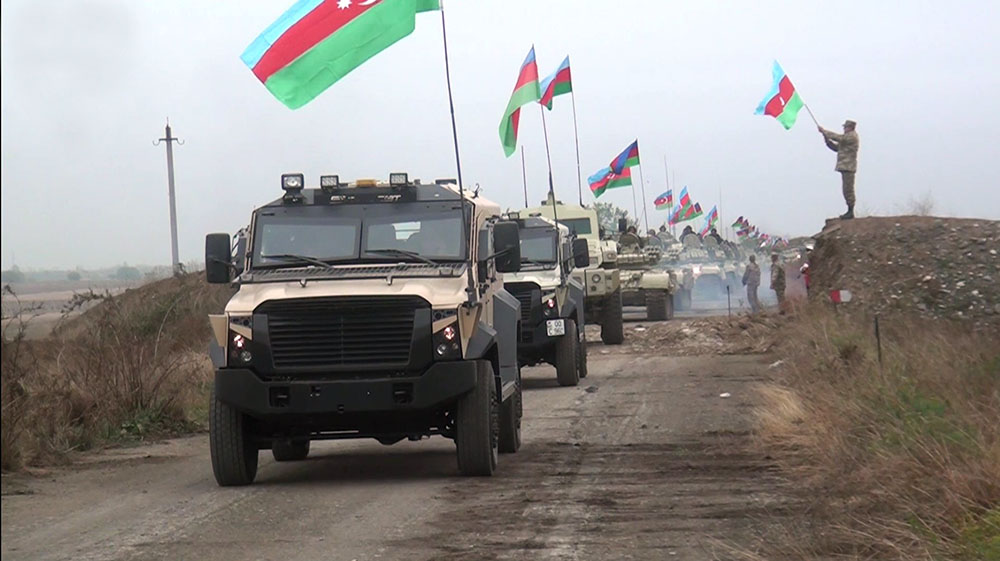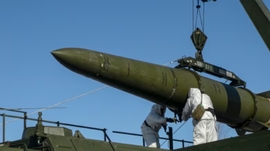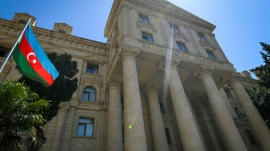The district of Aghdam, one of seven territories occupied along with the Nagorno-Karabakh region, has been returned to Azerbaijan on Friday after 27 years of Armenia's occupation.
Azerbaijani Defense Ministry announced that the national army has entered the district upon the tripartite agreement signed between Azerbaijan, Armenia and Russia on November 9. The trilateral ceasefire statement obliged Armenia to withdraw its forces from Aghdam and return it to Azerbaijan by November 20.
"The liberation of the Aghdam district is a historic event. Aghdam is the largest of the occupied districts in terms of population," President Ilham Aliyev said, adding "before the occupation, 143,000 people lived in the Aghdam district. At present, the population [including IDPs] of the Aghdam district is 204,000 people. Seventy-three percent of the district remained under occupation."
Armenia's forces occupied a significant part of Aghdam, including the city and 89 villages, which comprised about 73 percent of the district's territory, on July 23 in 1993. The occupied areas were razed to the ground transforming the district into a ghost town. A small number of villages of the Aghdam district remained under Azerbaijan's control following Armenia's occupation. About six thousand residents of the district have been killed and 126,000 have been forcibly displaced in the wake of Armenia's attack.

Aghdam, located 362 kilometers west of capital Baku, was one of the major centers of heavy, light, and food industries, as well as agriculture of Azerbaijan until it lost a larger part of its territory to the Armenian invasion. Plants and factories in the district churned out equipment for aerospace and communication industries; canned, bakery, and dairy products; carpets, construction materials, and many more. The city was home to the first bread museum in the USSR and the second of its kind in the world. The museum was ruined by Armenia's troops during 27 years of the occupation.
An airport, a music technical school and a drama theater operated in Aghdam prior to the district's fall. Thirty-eight collective and state farms, 24 construction-installation as well as 12 industrial enterprises, 74 schools, 105 healthcare facilities, 271 culture houses, and 99 clubs ceased their activities with the partial occupation of the district. Currently, the occupied part of the district lies in ruins with no signs of life.
Azerbaijan liberated a significant part of its occupied territories during a 44-day-long military operations from September 27-November 9. The conflict in the country's Karabakh region escalated after Armenia's troops deployed in the occupied Azerbaijani lands began shelling heavily military positions and civilian settlements of Azerbaijan. Continuous artillery fire prompted counter-offensive measures by the armed forces of Azerbaijan.
The Azerbaijani army regained control over around 300 settlements and unnamed strategic heights in the Karabakh region, including the cities of Fuzuli, Jabrayil, Zangilan, Gubadli and Shusha until the ceasefire statement ceased hostilities on November 10. The document obliged Armenia to return the occupied districts of Kalbajar, Aghdam and Lachin to Azerbaijan by December 1. Aghdam is the first Azerbaijani district that was liberated under the clauses of the legally binding document.
"Measures will be taken to develop these lands. First of all, demining should be carried out. That is also a time-consuming issue because the loathed enemy has planted mines across large areas. After that, work on infrastructure projects begins. Instructions have already been issued to analyze the existing infrastructure," President Aliyev said.
Armenia and Azerbaijan have been locked in a decades-old conflict over the Nagorno-Karabakh region, which is the internationally recognized territory of Azerbaijan. Following the Soviet Union’s dissolution in 1991, Armenia launched a military campaign against Azerbaijan that lasted until a ceasefire deal was reached in 1994. Armenia occupied 20 percent of Azerbaijan’s internationally recognized territories including the Nagorno-Karabakh region and seven surrounding districts. Over 30,000 ethnic Azerbaijanis were killed and one million were expelled from those lands in a brutal ethnic cleansing policy conducted by Armenia. Although the United Nations Security Council adopted four resolutions in 1993 demanding the immediate withdrawal of the occupying forces from the Azerbaijani lands and the return of internally displaced Azerbaijanis to their ancestral lands, Armenia failed to comply with all four legally binding documents.







 President Ilham Aliyev praised Azerbaijan’s cultural diversity as a key factor in fostering peace, stability, and unity within the country, where a...
President Ilham Aliyev praised Azerbaijan’s cultural diversity as a key factor in fostering peace, stability, and unity within the country, where a...
 Azerbaijan, Uzbekistan, and Kazakhstan are planning to merge their energy systems following a historic memorandum of understanding (MoU) signed by ...
Azerbaijan, Uzbekistan, and Kazakhstan are planning to merge their energy systems following a historic memorandum of understanding (MoU) signed by ...
 Iran confirmed that Afghanistan's first transit rail cargo has left for the Razi border crossing, in the country’s northwest region, following a ha...
Iran confirmed that Afghanistan's first transit rail cargo has left for the Razi border crossing, in the country’s northwest region, following a ha...



